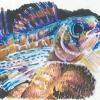Hi,
Last Wednesday I went seining in Clear Creek just outside of Bloomington, IN. I collected 14 fantail darters, but observed two different morphs: barred (E. f. flabellare) and striped (E. f. lineolatum). Tom Simon's Indiana fishes field manual has them listed as two subspecies of flabellare, but I can't find out much more about them. Does anyone know how divergent from one another they really are? I was hoping to run some experiments soon, but I might have to pick between the two subspecies for the project if I can't pool them together as a single population.








